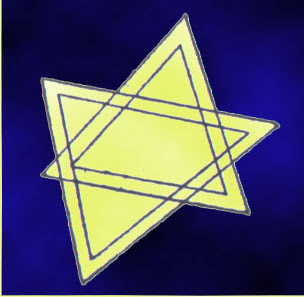
I took this photo from William Graham’s book, Culture and Conscience, Chicago University press, 1936, p. 245 and colored it a bit in Photoshop.
Graham wrote that it is incised on the side of a building of Megiddo. He thinks that this symbol originated in astrology and referred to S.A. Cook, The religion of Ancient Palestine in the light of Archaeology, pp. 213.
S.A. Cook wrote there:
Distinctively Jewish are…the pentagram or seal of Solomon, and the hexagram, or Shield of David…they may be of astral origin (Hilprecht, Explorations in Bible Lands, p. 529).
I already mentioned
that professor Michael Costa wrote in his Hebrew book about the Golden Section that this
Magen David, same as we recognize it today, drawn in lines, is from the period of King Ahab(853 - 874 B.C).

